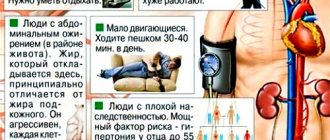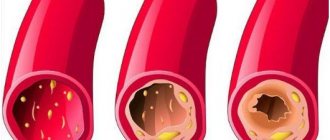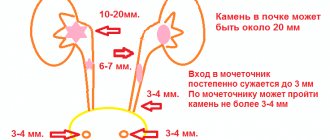Renal hypertension occurs only in cases of serious diseases of the structural elements of the kidneys and is accompanied by an increase in normal blood pressure values.
With long-term treatment, it is possible to restore its normal level by normalizing the glomerular filtration function.
The trend of this disease is towards rejuvenation. Hypertension itself is rarely noted as an independent disease, so you should find out what the person actually has.
How kidney pathologies affect blood pressure
Kidneys and changes in blood levels are interrelated concepts. If any of the internal organs operate abnormally, this will immediately affect the blood flow. This happens because the internal organs perform all the functions of cleansing the body of toxins and waste and removing all excess fluid. When these functions are disrupted, pathogenic substances remain directly in the bloodstream. This leads to very sharp and frequent jumps in pressure readings.
High blood pressure numbers always indicate that excess fluid has accumulated inside the body, while low blood pressure numbers occur due to dehydration. Therefore, the first thing prescribed when blood pressure increases are diuretics, which remove fluid from the body. Furosemide is often used for these purposes.
Hypertension appears due to persistent disturbances in the functioning of the heart and coronary vessels with damage to most of the renal parenchyma or the main blood vessels.
Diseases leading to the development of hypertension:
- nephritis or pyelonephritis, which have already become chronic;
- atherosclerosis of the main renal arteries;
- thromboembolism;
- urolithiasis disease;
- serious kidney injuries.
All of these pathologies lead to chronic kidney failure. And it reduces the level of necessary resistance of large and small vessels, which leads to long-term hypertension.
How to distinguish secondary arterial hypertension
Any damage to kidney tissue is accompanied by many negative changes in the body, and renal hypertension, which is a fairly commonly diagnosed disease, can cause a number of dangerous health consequences. Having characteristic external manifestations, renal hypertension can be detected in a timely manner, which allows treatment to be started sooner and the risk of side effects to be prevented.
Modern methods of diagnosing and treating kidney damage make it possible to minimize the possible negative manifestations of this disease and ensure a speedy recovery of the patient. Their use means the most comprehensive approach to treatment, the use of all available medical capabilities while simultaneously eliminating existing side effects.
It should also be remembered that any pathological processes occurring in the body make the process of curing renal hypertension longer and more complex, therefore their timely identification and elimination will reduce the time for healing the kidney tissues and returning them to the required degree of functionality.
Renal hypertension is characterized by the occurrence of pathological changes in the tissues of the kidneys, in which manifestations such as significant narrowing of the lumens of blood vessels, or stenosis, as a result of which disturbances and disruptions occur in the circulatory process, may occur. If the blood supply to tissues is disrupted, the amount of nutrients and oxygen entering them decreases, and severe hypoxia occurs.
Such changes entail an increase in pressure inside the kidneys, which further disrupts all processes in them. The condition of the kidneys in question tends to develop unnoticed, without significant external manifestations, therefore identifying it requires certain knowledge in the specifics of the work of this organ in order to promptly identify disturbances in its functioning.
Renal hypertension is most often diagnosed in men who have reached the age of 35-55 years; in women, this pathology develops relatively rarely. The condition in question may accompany some organic kidney diseases, for example, with pyelonephritis, nephrosclerosis, renal hypertension occurs several times more often than in the absence of manifestations of these diseases.
Renal hypertension can be considered a consequence of increased blood pressure (arterial hypertension). For this reason, this pathological condition is a consequence of other concurrent lesions that should be treated first to eliminate the manifestations of renal pathology.
Hypertensive nephropathy occurs due to a significant reduction in kidney tissue and the lumen of blood vessels in it. Deterioration of the blood circulation process entails malfunctions in certain areas of the kidneys, and excess fluid accumulates. The increased volume of blood in the kidneys also negatively affects the entire functioning of the organs. Failure in the excretion of sodium from the body leads to its gradual accumulation, which also negatively affects the entire functioning of the patient’s body.
An increase in peripheral resistance of blood vessels with constant irritation of special nerve receptors provokes active and excessive release of the hormone renin, which stimulates an increase in the tone of blood vessels and arteries. In this case, there is a gradual accumulation of deposits in the form of a pulp of soft consistency, which over time is deposited on the walls of blood vessels, which reduces the free lumen and also interferes with the blood circulation process.
This mechanism may explain the reason why this condition is detected predominantly in men and in people with increased body weight. After all, the greater a person’s body weight, the greater the volume of his bloodstream and the greater the likelihood of developing pathologies in its functioning.
Hypertensive nephropathy can have a number of serious complications that have a dramatic negative impact on your overall health. Understanding the danger to a person of having this kidney disease will allow you to promptly pay attention to any changes in their work and take the necessary measures to prevent the occurrence of aggravations and possible complications.
In the absence or insufficiency of therapeutic effects when this renal pathology is detected, the following consequences and complications are likely to occur:
- disorders in the condition of blood vessels;
- changes in blood composition;
- the appearance of atherosclerotic phenomena;
- heart failure;
- manifestations of renal failure, which leads to a gradual accumulation of fluid in the body.
The listed consequences that renal hypertension can have have a sharp negative impact on both the patient’s quality of life and his general condition, and can cause loss of performance, further disability and even death. Treatment of renal hypertension requires timely identification of disturbances in the functioning of the kidneys and the adoption of the necessary measures to eliminate them, since in the absence of sufficient attention there is a high probability of aggravation of the listed changes in the condition of the kidneys with a constantly progressive deterioration in their functioning.
Manifestations that cause kidney damage in hypertension will help to detect the disease at the earliest possible stage, undergo the necessary examination in time and begin treatment. The doctor will help determine the stage of the current pathological process, draw up a treatment plan that will quickly eliminate the external and most unpleasant manifestations of the current disease.
Renal hypertension symptoms may include the following:
- changes in blood pressure, while blood pressure can vary significantly in different limbs;
- heart murmurs, which can be quite noticeable or can only be heard when examined by a doctor;
- the appearance of a small amount of protein in the urine;
- increased heart rhythms and their disturbance;
- arrhythmia;
- headache.
With chronic renal failure, there may also be a violation of nitrogen excretory function and a decrease in the specific gravity of urine. Blood pressure changes in this disease, which should also be considered the main indicator of the onset of kidney problems. And since it is easier and faster to treat any disease, including kidney damage, at the initial stage of their development, you should promptly pay attention to any pathologies in the functioning of the kidneys and your own well-being in order to prevent a possible worsening of the pathological process.
Kidney diseases entail multiple negative changes in their tissues, which leads to disruptions in their functioning. And damage to the organs of the excretory system causes multiple negative changes in the body, so diagnostics will always allow you to maintain normal health and prevent disturbances in the functioning of all organs and their systems.
In case of severe chronic renal failure, a treatment regimen should be drawn up that will first eliminate the root causes of this condition. And since changes in blood pressure should be considered one of the main reasons causing disturbances in kidney function, eliminating the increase in blood pressure will minimize and completely eliminate possible negative consequences in kidney function.
DETAILS: Urological blood pressure packs
The symptoms of both pathologies are not very different, but there is still a clear difference: renal hypertension is not so often aggravated by crises, heart attack, or stroke
The symptoms of both pathologies are not very different, but there is still a clear difference: renal hypertension is not so often aggravated by crises, heart attack, or stroke. In addition, with renal destruction, almost immediate swelling of the soft tissues is observed. A sign of an increase or decrease in the amount of urine will help to track low or high blood pressure. In particular, before blood pressure increases, urine volume decreases significantly.
Any pathological process in the kidneys is associated with pressure and causes a decrease or increase in the production of pressor (increasing pressure) or depressor (lowering pressure) substances. But a change in pressure level leads to a slowdown in blood flow in the kidney, which provokes unpleasant symptoms in the patient.
The main and only symptom of renal hypertension is a sharp jump in lower pressure.
Systolic and diastolic (upper/lower) pressure is an indicator of the functioning of the cardiovascular system. Impaired kidney function may affect the indicators, but may indicate heart disease. Therefore, careful diagnosis and examination is required to identify the cause. The lower level, like the renal level, is judged by the presence of diseases of the filtering organs.
Signs and symptoms
Acute renal hypertension begins quite suddenly. At first, the pressure jumps sharply. Later, pain appears in the sacral and lumbar regions of the back. The condition does not change even after taking prescribed medications intended to lower blood pressure.
In the benign form, the pressure does not decrease; the lower pressure is always increased slightly more than the upper. The patient may feel shortness of breath and severe weakness. Often there is pain in the heart area.
Malignant is characterized by a rapid increase in pressure. Here the impact also falls on vision. Blood flow in the retina is disrupted. Severe headaches are noted, mainly in the occipital region, which are accompanied by dizziness, as well as nausea and even vomiting.
The main signs of renal hypertension look like this:
- renal and cardiac pressure increases, in rare cases, only renal pressure;
- headaches appear;
- pulse increases sharply;
- fast fatiguability;
- swelling of the arms and legs;
- lower back pain;
- a sharp increase in blood pressure levels.
Since blood filtration and urine formation are disrupted, all metabolic products remain directly in the bloodstream. This leads to a deterioration in the general condition of the body. Urine tests may reveal traces of protein. With bilateral kidney damage, complete closure of urine is possible.
Similarities and differences with cardiac hypertension
The symptoms of cardiac and renal hypertension are not very different. There is only one important point - kidney disease does not often have complications in the form of heart attacks and strokes. If kidney function is impaired, swelling of the limbs almost immediately develops. The amount of urine excreted will help you understand and monitor whether your blood pressure is low or high. When blood pressure rises, the amount of urine decreases.
The consequences of cardiac hypertension include:
- stroke;
- heart attack;
- complete or partial loss of vision;
- development of acute coronary syndromes.
- disturbance or complete cessation of blood circulation;
- renal failure;
- exacerbation of other chronic diseases.
The most common symptoms are:
- frequent urge to go to the toilet;
- periodic increase in body temperature;
- lower back pain;
- general weakness;
- 2-fold increase in daily urine output.
If renal hypertension develops, medications that help lower heart pressure do not work. It is important to contact a specialist in a timely manner and receive the necessary treatment.
How to distinguish renal hypertension from cardiac hypertension?
The symptoms of both pathologies are not very different, but there is still a clear difference: renal hypertension is not so often aggravated by crises, heart attack, stroke.
The symptoms of both pathologies are not very different, but there is still a clear difference: renal hypertension is not so often aggravated by crises, heart attack, stroke . In addition, with renal destruction, almost immediate swelling of the soft tissues is observed. A sign of an increase or decrease in the amount of urine will help to track low or high blood pressure. In particular, before blood pressure increases, urine volume decreases significantly.
Recommended reading:
Symptoms of drug-induced kidney damage and treatment
Important! If the functionality of the kidneys is impaired, blood flow to the organs slows down, water and sodium accumulate - all this causes swelling. Exceeding the concentration of sodium ions in the blood leads to swelling of the walls of blood vessels, which exacerbates the sensitivity of the latter. Damaged receptors are activated with the production of renin, and being converted into angiothesin, then into aldosterone, the substance significantly increases vascular tone, narrowing the lumens. The result is an increase in pressure. Additionally, the problem is aggravated by the reduced production of substances that reduce tone, causing the organ’s receptors to become irritated with increasing dynamics. Such a vicious circle is constantly fed and helps maintain high blood pressure in the patient.
Any pathological process in the kidneys is associated with pressure and causes a decrease or increase in the production of pressor (increasing pressure) or depressor (lowering pressure) substances. But a change in pressure level leads to a slowdown in blood flow in the kidney, which provokes unpleasant symptoms in the patient.
Kidney failure
Arterial hypertension in renal failure is extremely dangerous. It leads to the appearance of edema and a persistent increase in blood pressure. All this has a bad effect on the functioning of the heart and other internal organs.
In order to remove excess fluid from the body, various diuretics (furosemide, spironolactone) and antihypertensive drugs (captopril, lisinopril, enalapril) are used.
Diagnosis by a doctor
It is almost impossible to independently detect renal hypertension. This requires consultation with a therapist. Based on the symptoms present, he will determine the reasons that may provoke an increase in blood pressure.
Diagnosis of a sudden increase in diastolic pressure always begins with its control over a certain period. If the patient had signs of hypertension during this time, and the pressure did not drop below 140 to 90, the pathology is definitely present. In case of such a disturbance in the functioning of the kidneys, the doctor immediately prescribes complex therapy, which consists of normalizing glomerular filtration and reducing blood pressure to normal levels.
To accurately determine the diagnosis, the patient must undergo the following examinations:
- Take a general blood and urine test.
- Undergo antiography of the renal vessels. This is needed to assess blood flow in the kidneys.
- Ultrasound (ultrasound diagnostics) of the kidneys and large vessels. The structure and features of the organ are examined in detail, and possible pathologies or the presence of inflammatory processes are identified.
- Urography is performed to evaluate the urinary tract. A contrast agent is injected into a vein and the rate of its distribution in the kidneys is determined.
- If necessary, a biopsy is prescribed.
- Tomography of the renal vessels is mandatory. This is needed to examine all internal kidney damage.
- Dynamic scintigraphy, in which a special substance is injected and the time it takes to reach the kidney is measured. In the presence of pathology, it slows down.
All these measures should be carried out as soon as possible after the first unpleasant symptoms appear. With renal hypertension, only timely medical care will help.
Diagnostics
The earlier the diagnosis is made, the better the prognosis. The first call of elevated renal pressure is a difference of less than 30 units between the systolic (cardiac) and diastolic (renal) readings. In this case, the doctor must prescribe the following tests:
| Analysis name | What can be revealed |
| Kidney ultrasound | You can see signs of pyelonephritis, tumor growth |
| Ultrasound of renal vessels (Doppler) | Gives a detailed picture of the condition of the walls of the renal arteries, measure the speed of blood flow in the organ |
| Angiography with contrast | Detects the patency of blood vessels, shows the localization of narrowings |
| Excretory urography | X-ray examination with contrast – “sees” the size, shape, position of the kidneys |
| CT or MRI | Visualizes organ parenchyma and vessels by scanning |
| Puncture (biopsy) | Collection of material for cyto- or histological examination, which allows you to determine the extent of organ damage, identify a tumor, and establish its malignancy |
| Fundus examination | Visualizes the condition of blood vessels and the retina of the eye |
Lab tests:
- UAC, OAM - give an idea of the general condition of the body;
- the blood renin level allows you to accurately make a diagnosis;
- the concentration of aldosterone in the bloodstream helps diagnose adrenal tumors (with normal renin, an increase in aldosterone indicates tumor growth);
- Plasma catecholamines help differentiate fetochromocytoma (they are elevated in tumors);
- testing urine with various samples (Nechiporenko, Zimnitsky) allows us to identify the preservation of kidney function and glomerular filtration rate.
Diastolic pressure is measured with a conventional tonometer. To ensure the reliability of the data, you should not smoke or drink alcohol an hour before the procedure, visit the toilet before the measurement, and do not worry during tonometry.
Treatment of renal hypertension
Drug treatment of renal hypertension is aimed at normalizing blood pressure and combating kidney disease. To stabilize the patient's condition, the following drugs are used:
- Thiazide diuretics and adrenaline blockers - indapamide, spironolactone, furosemide. Treatment with these drugs is long-term and carried out continuously. Be sure to follow a special salt-free diet. The degree of renal failure is determined by the size of the glomerular filtration rate. This is a major factor that must be taken into account when prescribing treatment regimens.
- Antihypertensive drugs – enalapril, lisinopril, metoprolol, nifedipine, clonidine. They are used to normalize kidney function. With the development of secondary renal hypertension, Prazorin is considered the most effective. It strengthens and protects the kidneys until their functions are restored.
- Hemodialysis may be needed. In the intervals between its implementation, antihypertensive drugs are used. Also shown are remedies to strengthen the immune system.
Renal arterial hypertension can cause disturbances not only in the functioning of the kidneys, but also in the heart and even in the brain. Therefore, it is important to begin treatment immediately after making an accurate diagnosis.
A catheter is inserted into the renal artery and attached to a balloon. When the vessels dilate, the balloon inflates. Thus, the vessels are protected from further narrowing.
Surgical intervention is indicated if renal function is preserved. They resort to it in cases of stenosis or blocked lumens of the arteries. In the future, the patient may need a kidney transplant.
How to lower kidney pressure at home
If the disease is at an early stage and does not cause serious pain or disturbances in the functioning of the body, then you can treat it yourself at home. First, you should consult with your doctor so that he can assess the degree of development of hypertension and tell you how to effectively lower your kidney pressure at home. For these purposes, as a rule, diet therapy, infusions and herbs according to folk recipes, and light medications are used.
Tablets for kidney failure
All therapy is aimed at reducing upper renal pressure, relieving pain, and solving the main problem that provokes this condition in the patient. The signs of PG themselves indicate the development of a disease that affects the kidneys. The specialist must determine the relationship between pathologies and prescribe the correct course of treatment. Typically, the following tablets are used for kidney failure:
- Antihypertensive drugs. Prazosin and Dopegit, especially, have a good effect. with secondary development of pressure in the kidneys. Medicines have a protective effect on the organ until it restores its functions.
- Adrenergic blockers, thiazide diuretics . Taking them involves giving up a number of foods (diet without salt), the therapy lasts for a long time without interruptions. When developing a course of treatment, the size of the glomerular filtration rate should be taken into account; only a specialist can do this.
With timely initiation of treatment, these medications help regulate blood pressure (lower and upper). One of the main dangers of this pathology is that renal hypertension progresses very quickly, the brain and heart will be affected, so it is important to start treating the disease as quickly as possible. If the effectiveness of drug therapy is low, it is necessary to perform balloon angioplasty.
Folk remedies
This is one of the types of therapy that can be approved by a doctor. The effectiveness of infusions and decoctions depends on the stage and degree of development of the disease. Treatment of renal pressure with folk remedies must be combined with a proper diet (eat food without salt, give up alcohol, etc.). You can regulate the pressure using the following recipes:
- Bearberry infusion. Take 2 tbsp. l. crushed plant, pour boiling water into a glass. The infusion will be ready in 30 minutes. Drink it 4 times a day, 20 ml.
- The next recipe is a collection of 5 tbsp. l. flax seeds, 2 tbsp. l. birch leaves, 1 tbsp. l. blackberry and strawberry leaves. Use a coffee grinder to grind all the ingredients until you get a powder. Take 2 tbsp. l. prepared mass per 0.5 liters of boiling water. The product should infuse for 7 hours, then take 5 times a day for 3 weeks. Then you should take a break for 7 days and continue taking the traditional medicine.
- The following infusion for the treatment of renal hypertension is prepared from 3 tbsp. l. carrot seeds, which should be ground in advance in a coffee grinder or blender. Place them in a thermos, pour boiling water over them and leave for 10 hours. Strain the resulting mixture and drink 1 glass 5 times a day before meals. The course of treatment lasts 14 days.
Is home treatment possible?
It is possible to cure renal hypertension at home only in combination with drug treatment. The following products can be used in folk remedies:
- bearberry infusion;
- Dill seeds;
- a collection of birch, chamomile, cattail and centaury leaves.
Bearberry is good for lowering diastolic blood pressure. Dill seeds are used to cleanse the blood vessels of the kidneys. Leaf collection can relieve inflammation.
Each of these prescriptions must be previously agreed upon with the attending physician.
Folk recipes
Attention, if your attending physician has diagnosed you with increased renal pressure, having decided on traditional recipes, under no circumstances take them yourself, first listen to what the specialist himself thinks about this.
Improper treatment can have a detrimental effect on kidney health. In addition, folk remedies can never completely replace drug treatment; such an opportunity exists only at the initial stage of development of renal pathology.
What traditional medicines can a doctor recommend to eliminate congestion, pain, dizziness and improve the functioning of the immune system in case of kidney disease:
- Medicinal collection of: thyme, bear's ear, elecampane, birch leaves, marigolds, dill seeds, immortelle. All herbs need to be mixed in equal proportions, then take 3 tbsp. l. mixture and brew in 2 liters of boiling water. This decoction should be infused for about 5 or 6 hours, after which it should be drunk in small portions throughout the day until the drug runs out.
- A decoction based on staminate orthosiphon. To do this, take 30 grams per glass of boiling water. dry herbs, infused for 120 minutes. The product has good diuretic properties; one portion of the serving is drunk in the morning and the second in the evening.
- Infusion of red grape leaves. To prepare, you need to brew 60 grams. herbs in 1 liter of boiling liquid, then wait 3 - 4 hours and take 100 - 150 ml periodically after meals.
- Lingonberry tea. For 200 ml of boiling liquid, take 3 tbsp. l. lingonberry leaves, then infused for 2 hours, drunk to reduce pressure in the kidneys before meals, 1/2 of a glass.
If the doctor has recorded high renal pressure, then you should think about timely treatment. If you ignore this problem, over time it can cause changes in the structure of blood vessels and the appearance of various heart ailments. Patients often require therapeutic therapy to restore renal pressure throughout their lives.
Prevention and recommendations
Prevention of the disease is aimed not only at normalizing blood pressure, but also at eliminating the risk of developing diseases and severe kidney pathologies. In the presence of chronic diseases, it is recommended to take medications to support diseased organs, as well as to normalize metabolism.
Symptoms of renal hypertension should be monitored in patients with renal failure. Excessive stress and hypothermia should be avoided. Follow all recommendations of a specialist.
Comprehensive treatment of arterial hypertension should be supplemented with a salt-free diet. You need to introduce as many fresh vegetables and fruits into your diet as possible, completely abandon bad habits and limit physical activity. This will help reduce renal pressure and avoid the development of possible complications.
Kidney disease can cause secondary hypertension, which is called hypertension due to renal failure. The peculiarity of this condition is that, along with nephropathy, the patient experiences high values of systolic and diastolic pressure. Treatment of the disease is long-term. Arterial hypertension of any origin is a common cardiovascular disease and accounts for 94-95% of them. The share of secondary hypertension accounts for 4-5%. Among secondary hypertension, renovascular hypertension is the most common and accounts for 3-4% of all cases.
Medicines
Without medical intervention, it is unlikely that any patient will be able to independently guess what measures need to be taken in case of symptoms of increased renal pressure and how dangerous they are. From the point of view of doctors, it is necessary to treat renal pressure in a timely manner, since there is a risk of myocardial infarction, strokes, including atherosclerotic changes in the blood supply.
Drugs are prescribed not only taking into account the identified symptoms, but also the very reason that caused the increase in pressure in the kidneys:
- Betaloc, Corvitol, Carvedilol. Beta-blockers to eliminate the symptoms of renal hypertension of renovascular origin. In some cases, your doctor may prescribe calcium antagonists to prevent the development of signs of hypertension.
- Dapril, Lisinopril, Irumed. ACE inhibitors (angiotensin-converting enzyme) of a hypotensive nature. They help stabilize high renal blood pressure and the value of peripheral vascular resistance.
- Hypothiazide, Lorvas. Tablets with a diuretic effect.
- Lasix, Furosemide, Furon. Loop diuretics to improve renal circulation, cardiac activity and fluid excretion through the urinary tract.
- Ceftriaxone, Augmentin. Modern anti-inflammatory drugs to reduce the development of unilateral or bilateral inflammation in the kidneys.
In case of observed signs of hyperthyroidism or diabetes mellitus, patients receive medications in accordance with the ailments identified in them.
One of the most common drugs is Hypothiazide. This remedy is a powerful drug that has a diuretic effect. It helps to quickly reduce swelling and lower blood pressure. Recommendations for use:
- swelling;
- diabetes insipidus;
- AKI (acute renal failure);
- renal failure;
- arterial hypertension.
The most significant side effects include the following symptoms:
- dry mouth;
- arrhythmia;
- nausea and vomiting;
- prolonged constipation;
- abdominal pain;
- weakness and fatigue;
- reduced potency in men;
- dizziness.
For women, the intake limit is when breastfeeding.
The next most popular drug is Lasix. The release form of this medicine is tablets. This type of medicine for kidney failure significantly reduces blood volume, lowers blood pressure and has a very strong diuretic effect. Recommendations for use of this medicine:
- swelling of the body;
- renal failure;
- violation of urinary diversion;
- arterial hypertension;
- hepatic coma;
- dehydration;
- mitral stenosis;
- hypovolemia;
- obstructive cardiomyopathy.
The main symptoms and consequences after taking Lasix can be:
- nausea;
- constipation;
- stagnant bile processes;
- headache;
- severe pain in the abdomen;
- decrease in pressure;
- digestive disorders;
- drowsiness;
- convulsions;
- confusion.
Also, after taking Lasix, some processes associated with a decrease in platelet levels, muscle pain, urticaria and fever are observed.
Drugs like Lasix for kidney failure should only be prescribed by a specialist. Dosages of medication are prescribed depending on the nature of the disease and the patient’s condition. The manufacturer does not recommend treating a disease such as renal failure during pregnancy.
Pregnant and nursing mothers can take Ketosteril only under the close supervision of specialists.
Also, taking medications of this type should be accompanied by a diet with increased calorie content.
In some cases, doctors prescribe a remedy such as Reogluman. Based on the principle of its action, this drug is classified as a plasma replacement drug. It is designed to remove all toxic compounds from the body due to its diuretic and anti-shock principle of operation.
Contraindications for the use of this drug include:
- diathesis;
- anuria;
- allergic reactions to the active ingredients of the drug;
- heart failure.
The manufacturer strictly prohibits the use of this medicine during pregnancy.
Drugs for renal failure based on the plasma-replacement principle of action are very common. Such medications include Sorbilact. This drug has proven itself well in antishock therapy. It also has an excellent detoxification effect, promotes the rapid removal of excess fluid, and has an alkalizing and energetic effect.
Main indications for use:
- peritonitis;
- sepsis;
- cerebral edema;
- various liver diseases;
- renal failure;
- thyrotoxicosis;
- intestinal obstruction;
- traumatic shock;
- high blood pressure.
Like many modern drugs, Sorbilact has some contraindications for use. These include:
- dehydration of the body;
- allergic reactions.
Due to the fact that the drug has a powerful dehydrating effect on the human body, the manufacturer does not recommend using it during pregnancy. However, it is worth noting that there is no data on how the drug affects the fetus or the condition of pregnant women.
Where is the connection?
The occurrence of arterial hypertension in chronic renal failure (chronic renal failure) is due to changes in the normal functioning of the urinary system, when the blood filtration mechanism is disrupted. In this case, excess fluid and toxic substances (sodium salts and protein breakdown products) cease to be removed from the body. Excess water accumulated in the extracellular space provokes the appearance of swelling of internal organs, arms, legs, and face.
Large amounts of fluid irritate the kidney receptors, increasing the production of the enzyme renin, which breaks down proteins. In this case, there is no increase in pressure, but by interacting with other blood proteins, renin promotes the formation of angiotensin, which promotes the formation of aldosterone, which retains sodium. As a result, the tone of the renal arteries increases and the process of formation of cholesterol plaques, narrowing the cross-section of blood vessels, is accelerated.
At the same time, the content of derivatives of polyunsaturated fatty acids and bradykinin, which reduce the elasticity of blood vessels, decreases in the kidneys. As a result, in hypertension of renovascular origin, high blood pressure is persistent. Hemodynamic disorder leads to cardiomyopathy (left ventricular hypertrophy) or other pathological conditions of the cardiovascular system.
What is kidney pressure?
Renal pressure is a diastolic blood pressure indicator, the value of which deviates from the norm as a result of malfunctions in the renal system. The disease is diagnosed in 20-30% of hypertensive patients.
The kidneys filter the blood, remove excess fluid, breakdown products and harmful substances that accidentally enter the bloodstream.
Normal and impaired blood supply to the kidney
When the water-electrolyte balance is disturbed and the depressor system is suppressed, the organ begins to function incorrectly: the influx of plasma decreases, water and sodium are retained, causing swelling. Due to excess sodium ions, the walls of the arteries swell. Vessels become more sensitive.
Kidney receptors begin to synthesize an excess amount of the enzyme renin, which is transformed into angiotenis, and then into aldosterone. These elements are responsible for vascular tone, reduce the lumen of the arteries and lead to an increase in pressure.
Normally, lower (renal) pressure is in the range of 60-90 mmHg. Art.
The upper reading of the tonometer should not exceed 140 mmHg. Art. With hypertension of renal origin, blood pressure can increase to 250/150-170 mm Hg. Art.
The difference between systolic and diastolic readings ranges from 100 to 120 units.
The main sign of renal pressure is the ineffectiveness of antihypertensive drugs. This is explained by a specific regulatory mechanism.
Some disorders of the filtering organ can provoke a decrease in the tonometer numbers. But such a symptom is extremely rare.
Causes of renal failure due to blood pressure
The functioning of the renal arteries is impaired due to nephropathology. A common cause of nephrogenic arterial hypertension is arterial stenosis. A narrowing of the cross-section of the renal arteries due to thickening of the muscle walls is observed in young women. In older patients, narrowing appears due to atherosclerotic plaques that impede the free flow of blood.
Factors that provoke high blood pressure in nephropathies can be divided into 3 groups - negative changes in the parenchyma (kidney lining), damage to blood vessels and combined pathologies. The causes of diffuse pathologies of the parenchyma are:
- pyelonephritis;
- glomerulonephritis;
- lupus erythematosus;
- diabetes;
- urolithiasis pathologies;
- congenital and acquired kidney anomalies;
- tuberculosis.
Among the causes of renovascular hypertension associated with the condition of blood vessels are:
- atherosclerotic manifestations in the older age group;
- abnormalities in the formation of blood vessels;
- tumors;
- cysts;
- hematomas.
Nephrogenic hypertension is very resistant to medications that lower blood pressure.
A characteristic feature of nephrogenic hypertension is the ineffectiveness of drugs that lower blood pressure, even in the case of high values. Provoking factors can have a negative effect either individually or in any combination of damage to the parenchyma and blood vessels. In this situation, it is very important to identify existing problems in a timely manner. Patients diagnosed with renal failure require medical supervision by a physician. A competent specialist will be able to select complex therapy for the underlying pathology and medications to lower blood pressure.
The connection between kidneys and blood pressure
Nephrogenic arterial hypertension (renal pressure) is a disease that most often affects people in the older age category. You can cope with it only by following all the recommendations of a specialist. Kidneys and blood pressure have a close relationship. That is why people with disorders of the excretory system often have increased blood pressure.
The kidneys are a paired organ of the excretory system that is responsible for:
- blood filtration to cleanse it of harmful chemical components;
- removing excess fluid from the body.
With poor functioning of the organ and the presence of an excessive amount of fluid in the blood, blood pressure increases. Hypotension may also occur. This may be due, on the contrary, to an insufficient amount of fluid in the blood.
People with certain cardiovascular diseases are often prescribed diuretics (water pills). Taking them is essential for normalizing kidney function. Thanks to such drugs, blood vessels are cleansed of excess fluid.
Blood pressure levels may be elevated due to the presence of various diseases. This is also possible due to congenital abnormalities of the kidney tissue. The occurrence of hypertension may be due to the inability of the kidneys to fully remove salt deposits. The close connection between the paired organ of the excretory system and blood pressure is obvious. Increased blood pressure levels contribute to damage to kidney tissue, and this only aggravates the situation. Arterial hypertension occurs in almost all people with disorders in the functioning of the excretory internal organ.
- How to lower kidney pressure at home (lower it at home)
Course of the disease
Doctors distinguish two types of disease: benign and malignant. The benign type of renal hypertension develops slowly, and the malignant type quickly. The main symptoms of various types of renal hypertension are indicated in the table:
The disease can cause poor blood flow to the brain.
Arterial hypertension in pathological conditions of the kidneys provokes the following problems:
- disturbance of blood flow to the brain;
- changes in biochemical blood parameters (low hemoglobin and red blood cells, platelets, leukocytosis and increased ESR);
- bleeding in the eye;
- lipid metabolism disorder;
- damage to the vascular endothelium.
Return to contents
Symptoms of pathology
The symptom complexes of nephrogenic hypertension and arterial hypertension are similar:
- high blood pressure numbers;
- headache;
- aggressiveness;
- low ability to work;
- increased heart rate.
Signs of high blood pressure associated with kidney disease include:
- the appearance of pathology at a young age (up to 30 years);
- pain in the lumbar region;
- a sharp increase in blood pressure without active physical activity;
- different pressure in the right and left limbs;
- pasty limbs;
- retinopathy.
Return to contents
Treatment and its features
A set of therapeutic measures for nephrogenic hypertension is aimed at solving the following problems: stabilizing kidney function, restoring normal hemodynamics and lowering blood pressure. To solve these problems, drug therapy, hardware treatment and surgical methods are used. Therapy for lowering blood pressure is aimed at gently reducing blood pressure levels.
Patients with a history of diseases of the urinary system should take antihypertensive drugs, despite the deterioration of the excretion of end products of nitrogen metabolism. It is necessary to take into account the fact that for kidney diseases, basic therapy is used that affects blood pressure levels. Drugs may enhance or inhibit the effect of antihypertensive medications. An important condition for therapeutic measures is the prescription of complex medications with the least side effects.
Among hardware devices, phonation is the most popular. Exposure to sound waves contributes to:
- normalization of kidney function;
- increased secretion of uric acid;
- destruction of sclerotic plaques;
- normalization of blood pressure.
Surgical intervention for renovascular hypertension can be used in the presence of tumors that interfere with the normal functioning of the organ. For stenosis of the adrenal artery, balloon angioplasty is performed. Thanks to this operation, blood flow improves, the walls of blood vessels are strengthened and pressure is reduced. The last resort for correcting renovascular hypertension is nephrectomy or kidney resection.
In acute or gradually progressive renal dysfunction, blood pressure regulation is disrupted. Hypertension is most often noted; it requires a special selection of medications for control. Low blood pressure occurs in patients on program hemodialysis or is a reaction to massive antihypertensive therapy.











